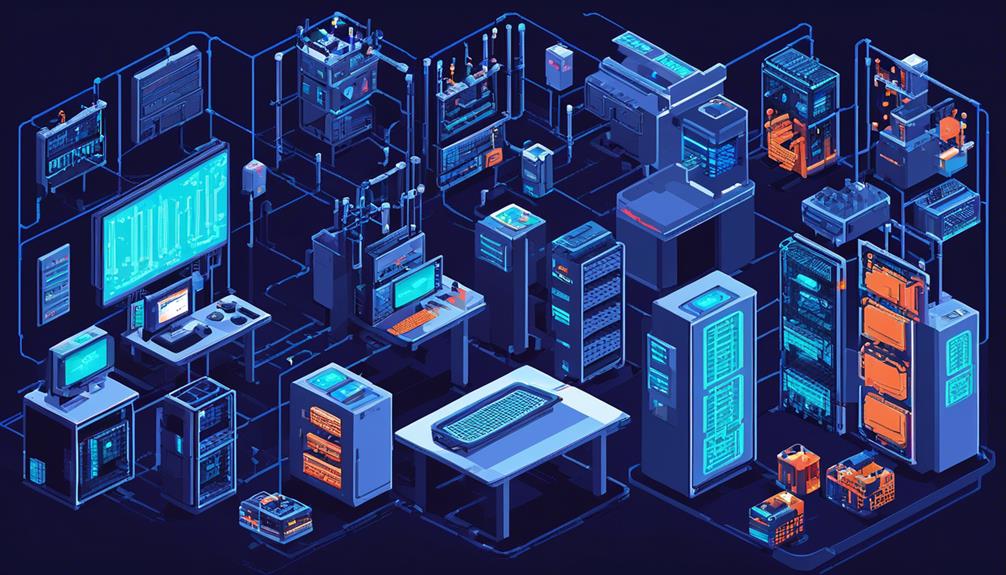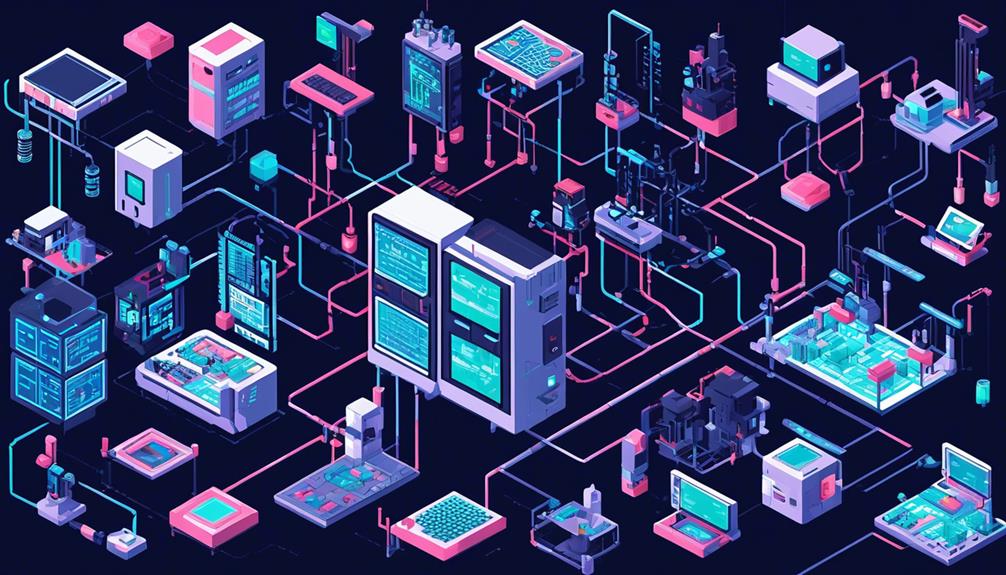As the landscape of network hardware continues to evolve, it is crucial for professionals in the field to stay informed about the future trends that will shape its trajectory.
From the convergence of WAN connectivity and security functions in cloud-based systems to the role of 5G and edge computing in driving new network requirements, the possibilities are vast.
Additionally, advancements in artificial intelligence and automation, as well as the growing demand for high-speed connectivity, will undoubtedly play a significant role in shaping the future of network hardware.
In this discussion, we will explore these trends and their potential implications, providing valuable insights into what lies ahead for network professionals.
Key Takeaways
- Software-Defined Networking (SDN) is transforming the networking landscape, providing flexibility, agility, and improved security through secure connections and reduced dependence on expensive hardware.
- Edge computing is revolutionizing network requirements, leading to the rise of Zero Trust Edge Architectures (ZTE) for secure WAN fabric support and the transition to a combination of software and hardware for agile network management.
- Advancements in network security technology, such as the adoption of ZTE and Business-Optimized Networks, are reducing the risk of unauthorized access, addressing security needs in edge computing, and challenging traditional networking market leaders.
- The growing demand for high-speed connectivity is driven by increasing reliance on bandwidth-intensive applications, seamless access to cloud-based resources, and the adoption of IoT and AI, requiring network infrastructure to meet these needs.
Increased Adoption of Software-Defined Networking (SDN)

The increased adoption of Software-Defined Networking (SDN) is transforming the networking landscape, providing organizations with enhanced flexibility and agility compared to traditional WAN systems. SDN leverages LTE and broadband internet services to access data, files, and applications at multiple locations, enhancing productivity and business agility. This technology allows for remote entry to cloud-based applications, optimally placing application data and services for effective outcomes.
SDN is gaining popularity as organizations recognize its potential to improve security. Many are experimenting with SDN, and it is expected to become the new norm as its benefits become more widely recognized. With SDN, organizations can establish secure connections between different parts of their network, reducing the risk of unauthorized access and data breaches.
The increased adoption of SDN also requires networking professionals to adapt to the trend. As the networking world shifts towards software-defined networking, professionals need to acquire coding skills to effectively manage and optimize these networks. They must have a deep understanding of network protocols, virtualization technologies, and software development principles to successfully implement SDN solutions.
In terms of network hardware, SDN allows organizations to decouple the network control plane from the data plane, making it possible to use commodity hardware instead of proprietary network devices. This shift to software-defined networking means that organizations can significantly reduce their dependence on expensive network hardware, leading to cost savings and increased scalability.
Emergence of Edge Computing in Network Infrastructure
As organizations embrace the increased adoption of Software-Defined Networking (SDN), the emergence of edge computing in network infrastructure is revolutionizing network requirements and driving a shift in networking strategies. Edge computing is transforming the way organizations place their application data and services, enabling them to achieve more effective outcomes across different edges such as enterprise, operations, engagement, and telco provider.
To better understand the impact of edge computing on network infrastructure, let's examine some key developments in this field:
| Development | Description |
|---|---|
| Zero Trust Edge Architectures (ZTE) | ZTE is a convergence of WAN connectivity and security functions into a cloud-delivered and cloud-managed system. It offers distributed, replicable deployments and secure WAN fabric support. This architecture ensures that all network traffic, regardless of the edge location, is treated with skepticism and subjected to verification and authorization. |
| Rise of smart technology | The rise of smart technology, particularly IoT sensors and controllers, is challenging traditional networking approaches. These devices require specialized hardware and protocols, driving the need for 5G and business-optimized networks to meet the demands of vertical specialization. |
| Transition to software and hardware combination | The networking world is transitioning from a hardware-focused approach to a combination of software and hardware. Infrastructure as Code is gaining popularity, and network automation is accelerating through SaaS-based solutions. This shift allows for more agile and flexible network management. |
| Network automation and convergence | The emergence of network automation through SaaS-based solutions and the adoption of Zero-Trust and Multicloud Networking are driving the need for highly available, automated networks. This convergence toward a single, business-wide networking fabric simplifies network management and enhances overall efficiency. |
These developments highlight the significant impact of edge computing on network infrastructure. As organizations continue to embrace this technology, they must adapt their networking strategies to ensure optimal performance and security. By staying ahead of emerging trends in edge computing, organizations can unlock the full potential of their network infrastructure and drive innovation in their operations.
Advancements in Network Security Technology

Advancements in network security technology have revolutionized the way organizations protect their digital assets and safeguard against cyber threats. With the increasing sophistication of cyberattacks, it has become imperative for businesses to stay ahead of the curve and continuously update their network security measures. Several advancements in network security technology have emerged in recent years, addressing the evolving challenges and requirements of modern networks.
One significant advancement is the adoption of Zero Trust Edge Architectures (ZTE). ZTE converges WAN connectivity and security functions into a cloud-delivered system, providing secure WAN fabric support. This approach ensures that every device and user on the network is verified and authenticated before granting access, regardless of their location. By implementing a Zero Trust model, organizations can significantly reduce the risk of unauthorized access and data breaches.
The role of 5G and Business-Optimized Networks in Vertical Specialization has also impacted network security technology. With the proliferation of smart technology and the Internet of Things (IoT), traditional networking solutions are no longer sufficient. Tailored solutions for IoT sensors and controllers are required to meet the specific security needs of these devices. This includes robust authentication mechanisms, encryption protocols, and secure communication channels.
Furthermore, the rise of Edge Computing has driven new network security requirements. Edge Computing optimizes the placement of application data and services across various edges, including enterprise, operations, engagement, and telco provider edges. This approach necessitates the implementation of security measures at each edge to protect data and ensure the integrity and confidentiality of critical information.
As the networking landscape evolves, traditional networking market leaders are experiencing a declining influence. The market now demands differentiation and innovative support for business-optimized networks. This has led to the rising use of Infrastructure as Code, with a shift towards software-defined networking. Networking professionals are required to learn coding languages and build solutions with standard software interfaces to meet the dynamic security needs of modern networks.
Growing Demand for High-Speed Connectivity
With the increasing reliance on bandwidth-intensive applications and emerging technologies, there is a growing demand for high-speed connectivity to support data-heavy operations and enable seamless access to cloud-based resources. Businesses across various industries are seeking high-speed connectivity to stay competitive in today's digital landscape. The rapid adoption of technologies like Internet of Things (IoT) and Artificial Intelligence (AI) necessitates network infrastructure capable of handling large volumes of data in real-time.
One of the key drivers behind the growing demand for high-speed connectivity is the proliferation of cloud-based services and applications. As more businesses migrate their operations to the cloud, they require reliable and high-speed connections to ensure uninterrupted access to resources. This is particularly critical for businesses that heavily rely on cloud-based collaboration tools and storage solutions.
Moreover, the increasing prevalence of remote work and distributed workforces further amplifies the need for high-speed connectivity. Employees working from home or remote locations depend on efficient network connections to access corporate resources and applications with minimal latency. High-speed connectivity enables seamless video conferencing, real-time collaboration, and efficient data transfer, ensuring productivity and smooth communication.
Another factor driving the demand for high-speed connectivity is the rise of edge computing. With the proliferation of IoT devices and the need for real-time data analysis at the network edge, high-speed connectivity is essential to enable efficient data transfer and communication between devices and central data centers.
Integration of Artificial Intelligence (AI) in Network Hardware

The integration of Artificial Intelligence (AI) in network hardware revolutionizes network requirements and enables more intelligent and proactive network management. By leveraging AI, network hardware can automate and optimize various processes, leading to improved efficiency and performance. This integration is paving the way for the development of autonomous network states, where AI-powered systems can self-manage and adapt to changing network conditions.
As AI continues to expand, its integration in network hardware will enable advanced applications across industries such as healthcare and manufacturing. With improved wireless speeds and network interfaces, AI-enabled network hardware can support real-time data analytics, predictive maintenance, and personalized healthcare solutions. This integration will not only enhance operational efficiency but also enable the development of innovative products and services.
The future of network hardware lies in the integration of AI, automation, and managed services to power next-generation networks. Networking professionals will need to acquire coding skills to navigate the shift towards software-defined networking and infrastructure as code. This will enable them to harness the full potential of AI-integrated network hardware and effectively manage complex network environments.
One of the key benefits of integrating AI in network hardware is the ability to optimally place application data and services. AI algorithms can analyze network traffic patterns, user behavior, and other relevant data to determine the most efficient routing and resource allocation strategies. This revolutionizes network requirements and ensures that critical applications and services are delivered with optimal performance and reliability across different network edges.
Frequently Asked Questions
What Is the Future of Networking Technologies?
The future of networking technologies is expected to be shaped by advancements in 5G technology, Internet of Things (IoT) connectivity, and software-defined networking (SDN). These developments will enable faster and more reliable wireless communication, seamless integration of IoT devices, and greater flexibility and automation in network management.
As organizations increasingly rely on these technologies to support their digital transformation initiatives, the demand for network hardware that can accommodate these requirements will continue to grow. This will drive the development of innovative solutions that can meet the evolving needs of modern networks.
What Do You Think Are the Future Development Trends of the Network?
The future development trends of network infrastructure will be influenced by the rapid growth of the Internet of Things (IoT) and the increasing adoption of cloud computing. These trends will require network hardware to be more scalable, flexible, and secure.
Network infrastructure will need to support the massive influx of IoT devices and the need for real-time data processing and analysis.
Cloud computing will drive the demand for high-speed and reliable connections to access and store data in the cloud.
What Are the Network Trends in 2024?
Network trends in 2024 will be driven by the increasing adoption of network automation, edge computing, and software-defined networking (SDN).
Network automation will continue to accelerate, with businesses leveraging SaaS-based solutions for efficient and streamlined network management.
Edge computing will revolutionize network strategies, enabling effective placement of application data and services across various edges.
SDN will play a crucial role in creating flexible and scalable networks, allowing organizations to adapt to evolving business requirements.
These trends will shape the future of networking, enhancing efficiency, security, and agility.
What Will Be the Hottest Network Technology in 2023?
The hottest network technology in 2023 is expected to be emerging network solutions that leverage advanced technologies to enhance network infrastructure.
These solutions will likely incorporate elements such as software-defined networking, zero trust edge architectures, and edge computing to provide secure and efficient network connectivity.
With the rise of smart technology and the increasing demand for tailored networking solutions, organizations will prioritize the adoption of these advancements to support their key business initiatives and gain a competitive edge.
